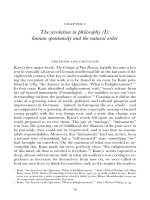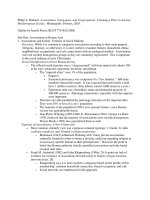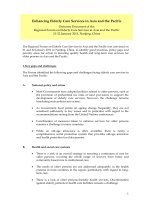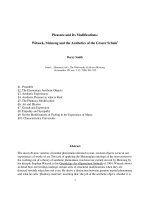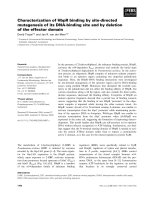EVERYTHING IN ITS RIGHT PLACE: FOUCAULT AND THE ''''IDEOLOGY OF THE AESTHETIC'''' pptx
Bạn đang xem bản rút gọn của tài liệu. Xem và tải ngay bản đầy đủ của tài liệu tại đây (185.26 KB, 13 trang )
111
Postgraduate Journal of Aesthetics, Vol. 1, No. 3, December 2004
EVERYTHING IN ITS RIGHT PLACE:
FOUCAULT AND THE 'IDEOLOGY OF THE AESTHETIC'
DOMINIC PATERSON
UNIVERSITY OF GLASGOW
There are several ways in which we 'rediscover' things. Sometimes rediscovering means finding
something we had thought lost—to take a relevant example, let's say a painting that was stolen, or
thought destroyed, that turns up in a dingy attic, from where it is rescued, and then authenticated,
valued and preserved, finally restored to its rightful place. In such an instance, there will be a
place waiting for the rediscovered painting from where it has been missing, and known to have
been missing; a blank space on a gallery wall. Rediscovery, in this mode, is a kind of restoration.
But there is another sense in which we 'rediscover'—when, for example, re-reading a book and
finding something in it that was overlooked the first time around—it might be that a book which
had meant little when read as a child, is rediscovered as a classic when re-read as an adult. In this
sense, what is rediscovered has been overlooked, not lost, and such a rediscovery has the
character of a re-appraisal.
In a recent issue of the journal Art History devoted to the rise of 'visual culture,' Peter
Osborne argues persuasively that the philosophical tradition of aesthetic theory in its Kantian form
has become divorced from the critical task of thinking about the specificity, the historical ontology,
of contemporary art.
1
Contemporary art is 'post-conceptual' Osborne claims, and as such has
moved 'beyond aesthetics.' Nonetheless, he sees philosophical or critical thought as key to the
possibility of re-empowering art critical discourse and assessing its relationship to art history. His
1
Osborne, P. (2004), .
112
DOMINIC PATERSON
aim, which I endorse, is to think through the historicity of contemporary art criticism and its
relationship to art history. That this aim derives from a conscious need is axiomatic for my
argument here. I will return, later in this essay, to another invocation of a 'historical ontology' that
announces its grounding in a contemporary critical need—one that appears in the work of Michel
Foucault—to sketch some general principles for a 'rediscovered' and reappraised aesthetics.
Key to Osborne's argument is his reading of Kant's Critique of Judgement as inaugurating a
tradition that wrongly identifies aesthetics with the philosophical discourse on art. Though an
aesthetic dimension may be ineliminable from art (this Osborne sees as one lesson of
Conceptualism), it is nonetheless the case that the 'art as aesthetics' discourse runs aground in
trying to deal with contemporary artistic practices that do not operate primarily via the aesthetic.
This has lead, in what Osborne terms 'a form of philosophical ressentiment,' to the 'end of art'
thesis, in various modes.
2
In a detailed argument that can only be alluded to here, Osborne sees
'aesthetics,' in the sense given to it by Kant, as a 'principled ignorance of art.'
3
The conception of
art developed by Jena Romanticism, which Osborne terms 'art as ontology' is presented as more
adequate to the historical specificity of contemporary art and the critical scene. But how is this
contemporary reality itself characterised?
The reconfigurations of discourse within the Humanities, the effects of postmodernism
understood both as late capitalist epoch and as post-structuralist theory, have led to much debate
within theoretically inclined art history concerning its relationships with philosophy—especially
insofar as art history is understood as founded on Kantian principles—and with criticism,
perceived as undergoing a crisis induced by its institutional redundancy.
4
One consequence of
these reconfigurations is the increasing prominence of 'visual culture,' with its massive expansion of
the types of objects considered along with paintings and sculptures under one remit, which
promises to democratise art history at the same time as it threatens to shatter the specificity of its
relationship to a set of privileged and canonical objects. As Osborne notes, one of the problems
2
Ibid., 655.
3
Ibid., 660.
4
See, for instance, Podro, M. The Critical Historians of Art, New Haven: Yale University Press, 1982, and
Baker, G., Buchloh, B. et al 'Round Table: The Present Conditions of Art Criticism,' October, No. 100 (Spring
2002).
113
DOMINIC PATERSON
raised by 'visual studies' as adjunct or replacement for art history is that it runs the risk of affirming
the idealist emphasis on opticality characteristic of formalist modernism, and of treating synchronic
connections across an expanded cultural field of analysis, whilst neglecting the historical
dimension.
5
That art historians might seek interdisciplinary connections with philosophy in these
circumstances is understandable, though the extent to which this necessitates 'rediscovering
aesthetics' remains to be seen. As Osborne argues, the aesthetics which philosophy has
traditionally associated with art is not what is needed to understand or to try to remedy, the
negative effects of convergent historical processes on art critical thought.
The word 'aesthetics' might itself be a complicating factor for the establishing of such
connections. Aesthetics signifies not only a branch of philosophy, itself hardly homogenous, but
also serves within recent art history as a name for the dynamics of the interpellatory operations of
art works or other cultural objects (where it is a question of the specific operations of a work), as
a name for the 'period eye,' a historically specific sensibility. If there has been a recurrence of the
term 'aesthetics' in recent art history and art criticism, it often signifies not the philosophical
tradition, but the specifics of a particular art work's mode of producing meaning, understood as
relating to a broader system of 'aesthetics-at-large.' Recent art history has tended to be more
interested in the way aesthetics make an art work work than in how they make it art. It might
seem that the solution to this confusing state of affairs should be a rigorous separation between
aesthetics in a philosophical, specialist sense, and general discussions of period sensibility etc. But
a rediscovered aesthetics cannot abandon either, not least because aesthetic experience as it takes
place in relation to art of the 20
th
century is deeply engaged with 'aesthetics at large' or 'at work.'
As Osborne notes, the aesthetic is a necessary dimension of the historico-ontological conception
of art, but is 'both partial and relational.'
6
As such, the analysis of a given work will need to treat
the specific historically determined character of the relationship between aesthetic and other
factors. 'Furthermore, these relations between the aesthetic and other aspects of art works derive
their critical meaning from their relations to the equally variable aesthetic dimension of other (non-
5
Osborne (2004), 652.
6
Ibid., 661.
114
DOMINIC PATERSON
art) cultural forms…'.
7
The multiple meanings and sites of 'aesthetics' are thus what we must
rediscover, rather than a harmonious and well-ordered organisation of clearly defined terms. If the
predominant metaphors that describe the role of aesthetics within the changing relationships
between philosophy, art practice, art criticism and art history, are of spatial expansion and
retraction, it is also important to figure these relationships via dispersal. The multiple loci of
invocations of 'the aesthetic' effect a decentring of its philosophical determination, and while this is
to an extent a consequence of processes of aestheticisation and of critical atrophy, it is also the
condition for a possible renewing of the critical project in the wake of poststructuralism.
The death of Jacques Derrida marks a key moment in the history of critical thought, in which
we not forced to decide again whether or not we wish to follow those who reconfigured so much
of 'theory.' With his passing, after that of Foucault, Lyotard, Deleuze, et al, do we have, finally,
closure on these authors, on this period, which is part of the history of critical thought, but perhaps
no longer defines it? One way of understanding the 'rediscovery' of aesthetics might be to see it as
a return to a way of thinking about philosophy and about art that was obscured by the emphasis in
poststructuralist theory on textuality, discourse, power etc. and by the irresponsible
'aestheticization' of critical writing. But the most urgent need for a 'rediscovered' aesthetics results
from the historical specificity of the place(s) of aesthetics in the present, not least in the textual
strategies of poststructuralism itself, which largely still await an aesthetically aware reading. Rather
than rediscovering a disciplined and secure locus for aesthetics within a hypothetically ideal
architecture of knowledge, I would argue that the task facing us is the discovery of modes of
critiquing and thinking about the ubiquity, undecidability, and centrality of aesthetics in every
aspect of our culture and our knowledge. As you may gather from the terminology I use here, I
think that this necessitates a continued engagement with poststructuralist thought. Particularly
within art history as it is practised this means a repetition of the reading of the now canonical texts
that were received within it as 'theory' at least 30 years ago. If, as Freud suggests, it takes two
traumas to make a trauma, I hope that such a continued engagement will facilitate a traumatic
rupturing of disciplinary boundaries and enable a more far-reaching critical investigation of
7
Ibid., 661.
115
DOMINIC PATERSON
aesthetics.
It is apparent now that postmodern culture as 'anti-aesthetic'—and the conjunction of artistic
and critical practices which promoted that concept—had an aesthetic of their own. The
retrospective recognition of an 'aesthetic' in works or texts that seemed formerly anti-aesthetic is
not a sign of their failure, nor of a dialectical reversal; rather I would argue it is part of the
becoming historical of things. The aesthetic is part of historical ontology. Historical distance
makes it clear that even those works that seemed the last word in the anti-aesthetic in fact partook
of a highly particular form, a mode of meaning that constitutes, and is usefully named, their
aesthetic. Of course, this interpretation might seem too general, too much in tune with common
usage, which tends to employ 'aesthetic' as a synonym for 'style,' and thus apply it to almost all
cultural objects. But it is the ubiquity, the pervasiveness of aesthetic questions that seems to me
precisely what needs to be theorized - an analysis of the aesthetics at work in all the ways in which
the world is interpreted and changed for us is politically important. I would argue, then, that what
Roland Barthes does in Mythologies, when he critiques the role of the haircuts in Julius Caesar,
the symbolic import to French culture of steak and chips, or a black child saluting the French flag,
is an analysis of the aesthetic at a certain level.
8
If we assume that all cultural stylizations are
products of an aesthetic by which they mean, then analysis of specific aesthetics means seeing
cultural forms, modes, objects, as determinate (to a degree) and knowable; and what is to be
analysed is the specificities of form, of surface.
It was just this analysis of surface that Foucault proposed as the aim of what he termed
'archaeology' or later 'genealogy.' It is Foucault's generation and their followers who may well be
held accountable for the 'loss' of aesthetics, and it is a certain distance from the hegemony of
'poststructuralism' that may make a restitution of traditional aesthetics possible. However, though
theoretically-inclined art historians have long utilised poststructuralist texts in the general project of
an attack on their discipline's bourgeois, connoisseurly bases, its 'bad' aestheticism, they have paid
little attention to the aesthetics at work in poststructuralist texts themselves. Michel Foucault has
been both enlisted by art historians wishing to overthrow their discipline's aestheticism, and been
8
Barthes (1993).
116
DOMINIC PATERSON
indicted by theorists (primarily Habermasians) who read him as an irresponsible aestheticist
(especially with regard to questions of normative judgement).
9
That diametrically opposite readings
of Foucault's position in relation to aesthetics can be made is all the more surprising when we
consider that similar interpretations of aesthetics are made by each camp. Both sides in this
example interpret aesthetics negatively because aestheticism is identified, with complicity with
forces of capital. How can Foucault be both a weapon against, and a victim of, these forces?
The concluding chapter of Terry Eagleton's The Ideology of the Aesthetic, 'From Polis to
Postmodernism'—which includes a discussion of Foucault's The Use of Pleasure—questions the
historical position of aesthetics in late-capitalism, and the discourses that seek to describe it.
Eagleton traces the historical fate of the concept of the aesthetic, with particular sympathy for the
meanings given to it by Kant and by Marx. The product of a response to historical developments
including particularly the rise of the bourgeoisie, the aesthetic is from the start implicated in what it
opposes.
On the one hand, it figures as a genuinely emancipatory force—as a community of subjects now linked
by sensuous impulse and fellow-feeling rather than by heteronomous law, each safeguarded in its
unique particularity while bound at the same time into social harmony. The aesthetic offers the middle
class a superbly versatile model of their political aspirations, exemplifying new forms of autonomy and
self-determination, transforming the relations between law and desire, morality and knowledge,
recasting the links between individual and totality, and revising social relations on the basis of custom,
affection and sympathy. On the other hand, the aesthetic signifies … a kind of "internalized
repression", inserting social power more deeply into the very bodies of those it subjugates, and so
operating as a supremely effective mode of political hegemony.
10
This basic model of the contradictory status of the aesthetic is found again and again in The
Ideology of the Aesthetic, but it is given different inflections along the historical path Eagleton
narrates.
Eagleton imagines that there was a time, before the rise of the bourgeoisie, when 'the three
mighty regions of the cognitive, the ethico-political and the libidinal-aesthetic were still to a large
9
See, for example, the essays collected in Critique and Power: Recasting the Foucault/Habermas Debate, ed.
M. Kelly, London: MIT, 1994.
10
Eagleton (1990), 28.
117
DOMINIC PATERSON
extent intermeshed.'
11
With modernity however, each region became autonomous; knowledge
slipped free of ethical constraint, and ethical questions became detached from cognitive ones.
Ethics now looked to the model of autonomous aesthetics as its guide, while the aesthetic, for its
part, became an end in itself, so detached from economic and political systems as to have little
choice in the matter. Of course, this autonomization is one way of characterising the achievements
of Enlightenment, and is thus not seen entirely negatively by Eagleton. Rather, and art is given as
the key example, an ambiguous process of autonomization as both increasing room for manoeuvre
and diminishing of critical purchase characterises the historical fate of the 'three mighty regions' in
modernity. Art becomes autonomous, paradoxically, in its integration into capitalist production,
and while art is marginalized, the aesthetic is generalized. 'Indeed one might risk the rather
exaggerated formulation that aesthetics is born at the moment of art's effective demise as a political
force, flourishes on the corpse of its social relevance.'
12
Art production withers in significance, but
bequeaths aesthetics as an ideological salve to a social order which has 'marginalized pleasure and
the body, reified reason, and struck morality entirely empty. The aesthetic offers to reverse this
division of labour, to bring these three alienated regions back into touch with one another, but the
price it demands for this generosity is high: it offers to interrelate these discourses by effectively
swallowing up the other two. 'Everything should now become aesthetic.'
13
It is worth noting here
that Eagleton's diagnosis is the opposite of Osborne's, for whom it is art that outlives aesthetics,
not vice versa.
In the post-war period instrumentalization cannot be simply opposed to 'culture' any longer;
'civil society' reshaped by consumer capitalism becomes 'pervasively aestheticized' via the
saturation of late capitalism's 'fetishism of style and surface, its cult of hedonism and technique, its
reifying of the signifier and displacement of discursive meaning with random intensities.'
14
Where
capitalism had first severed the symbolic and the economic, it now harnessed the former to the
latter, with postmodernism resulting. Though postmodernism could be viewed as a new variant of
11
Ibid., 366.
12
Ibid., 368.
13
Ibid., 368.
14
Ibid., 373.
118
DOMINIC PATERSON
avant-gardism, it is clear that Eagleton sees it in a negative light, as a ressentiment against truth,
morality and beauty, and against any hope of recovering them from instrumentality. This
capitulation is witnessed, or so Eagleton would have us believe, in postmodernism's 'consumerist
hedonism and philistine anti-historicism, its wholesale abandonment of critique and commitment, its
cynical erasure of truth, meaning and subjectivity, its blank, reified technologism.'
15
Eagleton, keen to diagnose poststructuralism as ailing from the same disease as late capitalist
culture generally, sees Foucault's 'radical, implacable refusal' as compromised by his relativism. If
politics must have recourse to normativity, and cultural relativism undermines this ground, Eagleton
sees Foucault's objection to 'regime as such' as his response to this problem.
16
Foucault,
Eagleton argues, is both a fantastical escapist, imagining life outwith institutional regime, and a
pessimistic pragmatist. 'This ambivalence then allows him [Foucault] to combine, in a manner
typical of much post-structuralism, a kind of secret apocalyptic ultra-leftism with a dry-eyed,
pragmatic political reformism. It protects him at once from the reactionary and the romantic…'
17
Thus, for Eagleton, Foucault has neither grounds, nor desire, to distinguish fascism from liberalism.
Eagleton accuses Foucault of being in thrall to power, of finding 'aesthetic gratification'
18
in it,
something that is apparently betrayed by Foucault's stylistic 'carefully calculated clinical
neutrality'.
19
The judgement which relativism had undermined as epistemologically viable, is in fact
passed over into the realm of the aesthetic, leading Foucault, according to Eagleton, to display a
'dangerous inclination towards absolutist coercion as against Enlightenment hegemony.'
20
In the
light of this reading of Foucault's general project, which does not in the end seem to do more than
exemplify the double-bind Eagleton has associated with the aesthetic from the start ('In so far as
power remains politically oppressive, it must call forth refusal and resistance; in so far as it is
aestheticized, it acts as the medium of a pleasurable expansion and productivity of capacities')
21
,
The Use of Pleasure is presented as an aesthetic response to an ethical lacuna in Foucault's
15
Ibid., 373.
16
Ibid., 385.
17
Ibid., 386.
18
Ibid., 388.
19
Ibid., 384.
20
Ibid., 389.
21
Ibid., 390.
119
DOMINIC PATERSON
œuvre. From Foucault's presentation of Greek sexual ethics as based on an aesthetics of conduct
and an economics of pleasure, Eagleton extrapolates the total renunciation of any criteria of
judgement other than stylistic, and reads The Use of Pleasure not at the level it was written, as
counter-point to the modern hermeneutic of the subject, but as if it intended to found a social
morality in general. This licences, it seems, a piece of insinuation that sits uneasily with Eagleton's
tone of ethical outrage. Having claimed that 'It is true… that Foucault, at least at one point in his
life, opposed the criminalization of rape.' This is itself a severe simplification, but its rhetorical force
is added to when later in the same paragraph Eagleton asks 'Does it all come down to a question
of how, in postmodernist vein, one "stylizes" one's conduct? What would a stylish rape look like,
precisely?'
22
The rhetorical escalation that occurs here shows how Eagleton's own understanding
of an aesthetic that should function in relation to, but distinction from, the ethical and the cognitive
leads him to read Foucault as symptom of a contemporary malaise. It does so moreover, in a
most ironic way, for Eagleton's own unethical recourse to an aesthetic device, a rhetoric of
persuasion, shows that he too cannot keep these realms as pure as he would like. Unable to read
Foucault's text as an aesthetically charged response to ethical and cognitive problems in
contemporary Western society, Eagleton performs the operation he accuses Foucault of, the
dissolution of ethico-political and epistemological concerns in a hypertrophied aesthetic.
Eagleton's idealised/idealist view of the aesthetic, his attempt to keep it separate from the life-
world he sees as disastrously aestheticized by capital, in fact works counter-productively. Unlike
Foucault he is unable to rearticulate historical processes and there concomitant transformations of
subjectivity as sites of critical intervention and resistance. Thus, whereas the late Foucault began a
project of 'the aesthetics of existence' that took contemporary narcissism as one of its inspirations,
Eagleton remains unable to utilise any of the aestheticising developments he can so lucidly
describe, instead harking back to a prelapsarian and narrowly metaphysical version of the
aesthetic as the ludic grounds of affective community.
23
This particular and elusive version of
22
Ibid., 394. On the episode to which Eagleton misleadingly alludes see Macey, D. The Lives of Michel
Foucault, London: Hutchinson, 1993.
23
On Foucault's utilization of narcissism as a means of a critical 'aesthetics of the self' see Technologies of the
self : a seminar with Michel Foucault, ed. L. Martin, H. Gutman, P. Hutton, Amherst, Mass: University of
120
DOMINIC PATERSON
aesthetics is not only unjustifiably kept separate from aesthetics-at-large, but also fails to respond
to the critical need for a counter-ideological investigation, and use of, such aesthetics as at work in
critical and theoretical writing.
Why is it that Eagleton, whose project as set out in the foreword of The Ideology of the
Aesthetic, should be accommodating to Foucault, finds it necessary to refuse him so thoroughly?
The answer to this lies, I think, in a resistance to one of the consequences of his own argument
regarding the ubiquity of the aesthetic. Capitalism having so thoroughly and insidiously
disseminated aesthetics via the commodity, Eagleton wishes to re-establish the grounds for a more
decorous and restrained aesthetics that is kept check by ethics and epistemology. The problem
Eagleton both recognises and obscures in The Ideology of the Aesthetic is the impossibility of
keeping the aesthetic in its place. This is one reason, perhaps, why his reading of Foucault proves
unproductive for him—because he cannot make sense of the aesthetics at work in the text,
aesthetics which play out the ethical and epistemological effectiveness of Foucault's writing. That
Eagleton's oversight on this point is inseparable from the unethical use of insinuation with regard to
Foucault, and from the epistemological shape of his reading demonstrates the inevitable
coexistence of these three, hypothetically separate modes. The supposed incommensurability
between the aims of Eagleton's analysis of the 'Ideology of the Aesthetic' and Foucault's
genealogical project remains undecidably located, neither finally assignable to epistemological or
aesthetic objections. The role ethics plays here is key. If, as Derrida has argued, the ethical
moment occurs precisely when one is faced with genuine undecidablility, then we might question
Eagleton's ethical response to equivocations that occur both within Foucault's text and in
Eagleton's reading of it.
24
That Eagleton seems resistant to both negative and positive
consequences of the ubiquitous 'aestheticization' he theorises as the postmodern condition does
not mean that his project is not worthwhile, merely that we cannot expect a rigid architecture of
aesthetic, ethical, epistemological to satisfactorily analyse a state of affairs in which such an
Massachusetts Press, 1988.
24
Derrida (2004).
121
DOMINIC PATERSON
architecture doesn't any longer exist.
That Foucault's project can in fact be seen as contributing to the 'historical ontology' outlined
by Osborne as the motivating need behind the rethinking of the relations between philosophy, art
history and art criticism, is clear from his essay What is Enlightenment?
25
This essay, further,
shows how aesthetic concerns are indeed central for Foucault, but that they do not, contra
Eagleton, overwhelm or undermine historico-critical ones. What is Enlightenment? brings
together two perspectives on the critical project; that of Kant, summarised as the posing of the
question Was ist Aufklärung? (seen as a new way of reflecting on the present), and that of
Baudelaire, whose aesthetic theory facilitates Foucault's transition from the self-questioning of the
Enlightenment to what he terms 'the historical ontology of ourselves.'
26
This transition both locates,
in Kant's critique, the point of departure for modernity, and conceives modernity not as an epoch,
but as an 'attitude,' by which Foucault means 'a mode of relating to contemporary reality; a
voluntary choice made by certain people; in the end a way of thinking and feeling; a way, too, of
acting and behaving that at one and the same time marks a relation of belonging and presents itself
as a task.'
27
Baudelaire, acutely aware of modernity, does not see being modern as merely a
matter of recognizing its fleetingness, its contingency. Rather, Foucault stresses, it is a matter of
adopting a deliberate attitude which 'consists in capturing something eternal that is not beyond the
present instant, nor behind it, but within it… Modernity … is the will to "heroize" the present.'
28
Baudelaire's famous comments about the 'poetic beauty' of the black frock-coat, and on Guys as
'painter of modern life' are quoted in support of this. Guys is quintessentially modern in that he
doesn't just depict, but transfigures the world he sees. 'For the attitude of modernity, the high
value of the present is indissociable from a desperate eagerness to imagine it, to imagine it
otherwise than it is, and to transform it not by destroying it but by grasping it in what it is.' But,
further to this modernity is a relationship to oneself, not just to the present, and for Foucault, the
25
Foucault (1997).
26
Ibid., 315
27
Ibid., 309.
28
Ibid., 310.
122
DOMINIC PATERSON
attitude of modernity is 'tied to an indispensable ascetism.'
29
Ascetism is perhaps Foucault's key
term for the understanding of the relation to self as aesthetic practice, for the self as work of art.
The brief characterisations of Kant and Baudelaire are not given as historical summaries of epochs:
while for Foucault we remain rooted in the Enlightenment, this connection is found not in
'faithfulness to doctrinal elements' but in 'the permanent reactivation of an attitude—that is, of a
philosophical ethos that could be described as a permanent critique of our historical era.'
30
The 'historical ontology of ourselves' Foucault proposes in What is Enlightenment? reflects
on limits, but in a different modality from Kantianism: 'if the Kantian question was that of knowing
what limits knowledge had to renounce exceeding… the critical question today must be turned
back into a positive one: In what is given to us as universal, necessary, obligatory, what place is
occupied by whatever is singular, contingent, and the product of arbitrary constraints? The point,
in brief, is to transform the critique conducted in the form of necessary limitation into a practical
critique that takes the form of a possible crossing-over.'
31
If Eagleton reads Foucault as dissolving
the ethical and the cognitive into the aesthetic, What is Enlightenment? makes it clear that the
role of aesthetics for critical thought is thoroughly historical, and connected to an ethics at both
personal and societal levels. That 'crossing-over' is thought by Foucault as an aesthetic, political
and an epistemological task is made eminently clear by the intertwining of these themes in the
writing collected in the Essential Works.
32
Osborne's analysis of the conditions under which art criticism might be reimagined as a
historical ontology of the present establishes both the inadequacy of the 'art as aesthetics' thesis,
and the ineliminability of the aesthetic dimension of artworks. Eagleton's The Ideology of the
Aesthetic offers a historical analysis of the social forces that have shaped the contemporary scene
from which Osborne starts out, and which continues to produce the need for critical and
philosophical engagement with art historical problematics. Yet it is Foucault, I would argue,
overlooked by Osborne and rejected by Eagleton, who comes closest to articulating aesthetic
29
Ibid., 311.
30
Ibid., 312.
31
Ibid., 315.
32
The interrelation of these domains is evident not least in the blurring of lines across the three volumes of the
Essential Works: Ethics, Aesthetics and Power.
123
DOMINIC PATERSON
concerns with the ongoing critical task of a 'historical ontology of ourselves.' It is in the service of
this aim that a rediscovery of aesthetics would be most useful.
REFERENCES
BARTHES, R. (1993), Mythologies, London: Vintage.
DERRIDA, J. (2004), 'Following Theory,' in Life After Theory, ed. Payne & Schad, London:
Continuum.
EAGLETON, T. (1990), The Ideology of the Aesthetic, Oxford: Blackwell.
FOUCAULT, M. (1997), 'What is Enlightenment?' in The Essential Works of Foucault 1954-
1984: Ethics—Subjectivity and Truth, ed. Rabinow, London: Penguin.
OSBORNE, P. (2004), 'Art Beyond Aesthetics: Philosophical Criticism, Art History and
Contemporary Art,' Art History, Vol. 27 (4).
